
Aconites are one of the showiest flowers out at the moment. I caught sight of a bunch as I walked up St Mary’s church path, shining yellow alongside a group of snowdrops. By flowering now they are living up to their latin scientific name (part of which is derived from Greek!) Eranthis hyemalis which literally means ‘Spring flowering in winter’ (ear – spring, anthos – flower, hiemalis – of winter). Aconites were brought here from Southern Europe to decorate our gardens as early as 1596. They gradually spread into the wild and are now common across central England and the eastern side of Great Britain. Despite coming from the Mediterranean, they clearly cope well with our colder winters!

Aconites belong to the buttercup family – no surprise you would think, given the similarity of their yellow petals with the glossy yellow petals of the buttercups that flower later in the year. Except what looks like their petals are not petals at all. A flower usually has two whorls or rings of leaf like structures that circle the flowers’ female and male organs. The structures in the outer whorl are the sepals. These are often small and green. Their role is to protect the flower in bud.

The petals sit inside the whorl of sepals. Their role is to attract insects to pick up pollen from the male organs and transfer it to fertilise the female organs, preferably of another plant. As petals’ role is to attract, they are usually larger than sepals and brightly coloured.
Only when I read up about aconites and looked more closely at their flowers did I discover that their yellow ‘petals’ are actually the sepals. Looking closer I realised there is no ring of green – or any other colour – leaf-like structures where the sepals should be. I then was pointed to tiny tubular structures that are round the inside of the base of the flower and blow me down, there are the petals, but much reduced in size and acting as nectaries. Instead of attracting insects by their size and colour, aconites’ petals do so by secreting sugary nectar. Just what hungry insects are desperate for in this freezing weather.
In many ways, who cares whether the yellow ‘petals’ are really petals or are actually sepals? Yet if we understand this, we are able to appreciate that by looking at an aconite we are seeing evolution in action. Aconites have so much of the simplicity of the earliest flowers – each sepal is separate, not fused in any way to the others; lots of anthers and carpels (the male and female parts). Yet the tubular petals show that aconites have moved on a bit from buttercups in the evolutionary journey – a journey that has produced the complex flowers of orchids.

If there is an aconite that you can pick, put it in a small jar on your table and you have evolutionary history in front of you. And a little bit of winter flowering sunshine that also smells lovely!
Subscribe to my blog.
Enter your email address and click Subscribe to follow this blog.
You’ll get an email each time I add another post.
This work is licensed under a Creative Commons Attribution-ShareAlike 4.0 International License.

